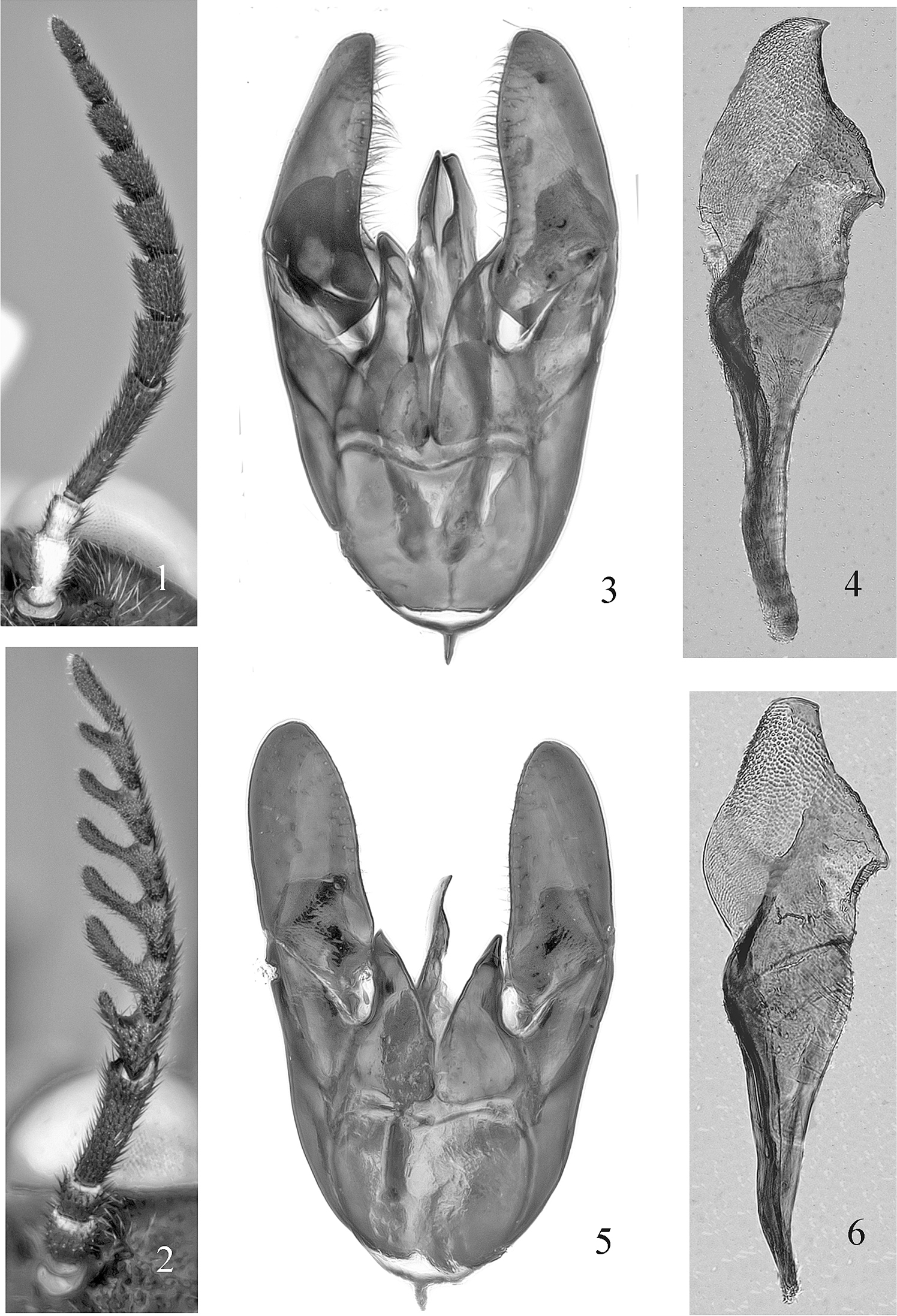






(C) 2012 David R. Smith. This is an open access article distributed under the terms of the Creative Commons Attribution License 3.0 (CC-BY), which permits unrestricted use, distribution, and reproduction in any medium, provided the original author and source are credited.
For reference, use of the paginated PDF or printed version of this article is recommended.
Beldonea Cameron is an unusual genus of Tenthredininae, which, in part, is distinguished from other genera of the subfamily by the serrate antennae of the female (Fig. 1) and pectinate antennae of the male (Fig. 2).
The genus and species, Beldonea impunctata (Wei), are recorded from Thailand for the first time. The presence of the genus in Thailand is not surprising since it has been recorded from Malaysia (Malay Peninsula), China (Hainan and Yunnan), and northeastern India (as Flagellaria,
The male of Beldonea impunctata was unknown, but the series from Thailand associates the sexes, and the male is here separated from that of Beldonea okutanii from India. Both are distinguished from Beldonea fumosa Wei by the rounded apex of the penis valve (Figs 4, 6) as opposed to the acute apex in Beldonea fumosa (
New records for Beldonea impunctata are as follows: THAILAND: Phetchabun, Khao Kho NP, deciduous forest at Ta Pol river, 16°32, 539’N, 101°2.483’E, 242 m, Malaise trap, 26.v-2.vi.2007, Sonchai Chachumnan & Saink Singtong leg, T2558 (1 ♂); Kamphaeng Phet, Mae Wong NP, Chong Yen, 16°5.968’N, 99°6.472’E, 1306 m, Malaise trap, 1–8.x.2007, Chumpol Piluk & Aram Inpuang leg, T2816 (1 ♂); Kamphaeng Phet, Mae Wong NP, Chong Yen, 16°5.212N, 99°6.576’E, 1306 m, Malaise trap, 14–21.iv.2008, Piluek C. leg, T3633 (1 ♂); Kamphaeng Phet, Mae Wong NP, Chong Yen, 16°5.968’N, 99°6.472’E, 1306 m, Malaise trap, 3–10.ix.2007, Chumpol Piluk & Aram Inpuang leg, T2812 (1 ♀, 1 ♂); Chiang Mai, Doi Phahompok NP, Headquarter, 19°57.961’N, 99°9.355’E, 569 m, Malaise trap, 18–25.vii.2007, Seesom. K. leg, T2947 (1 ♂); Chiang Mai, Doi Phahompok NP, Headquarter, 19°57.961’N, 99°9.355’E, 569 m, Malaise trap, 25.vii-1.viii.2007, Wongchai. P. leg, T2951 (1 ♂); Chiang Mai, Doi Chiangdao NP, Pha Tang substation, 19°24.978’N, 98°54.886’E, 526 m, Malaise trap, 4–11.ix.2007, S. Jugsu & A. Watwanich leg, T5682 (1 ♂); Chiang Mai, Doi Phahompok NP, Headquarter, 19°57.961’N, 99°9.355’E, 569 m, Malaise trap, 1–7.viii.2007, Wongchai, P. leg, T2949 (2 ♀). Specimens are deposited in the Queen Sirikit Botanical Garden Entomological Collection, Chiang Mai, Thailand, and the National Museum of Natural History, Washington, D.C., USA (USNM).
I have examined a female and a male of Beldonea okutanii collected from the type locality: India, Sikkim, Gangtok, 1750 m, 11-5-86, M. Saini (USNM).
Antennae and male genitalia. 1 Female antenna of Beldonea impunctata. 2 Male antenna of Beldonea impunctata 3 Male genital capsule, ventral, of Beldonea impunctata 4 Penis valve, lateral, of Beldonea impunctata 5 Male genital capsule, ventral, of Beldonea okutanii 6 Penis valve, lateral, of Beldonea okutanii.
Acknowledgments are due to National Science Foundation Grant DEB-0542864, Thailand Biodiversity Survey, to M. J. Sharkey, University of Kentucky, Lexington. Michele Touchet, Systematic Entomology Laboratory, USDA, Washington, D.C. (SEL) helped with the images. I thank J. Prena and T. J. Henry, SEL, Washington, D.C. for reviewing the manuscript. USDA is an equal opportunity provider and employer.
